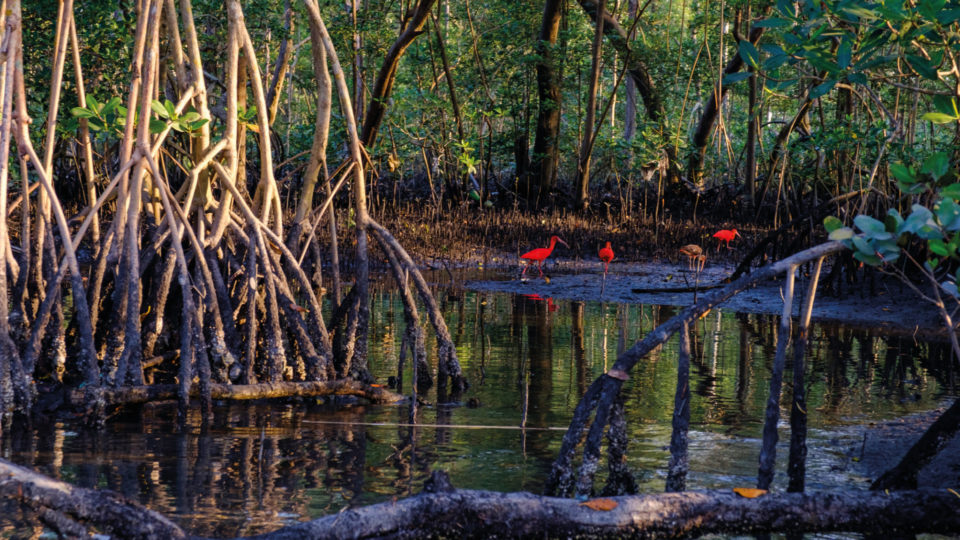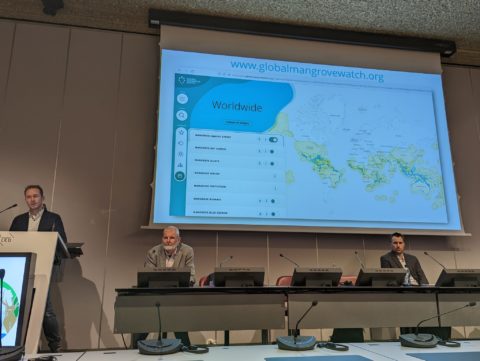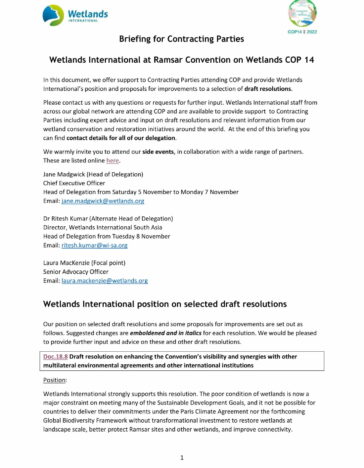
Wetlands 2022: from Ramsar to the CBD COP15
-
Climate mitigation and adaptation
Whilst the UN climate conference was getting underway in Egypt two weeks ago, the Ramsar Convention on Wetlands held its own Conference of Parties, where the role of wetlands – including mangroves, peatlands, sea-grass, marshes, and mudflats – in tackling the interconnected climate and biodiversity crises took centre stage.
Representatives from 146 governments adopted 21 resolutions to advance action on wetland conservation, restoration and wise use. The achievements and outcomes agreed by governments at the Ramsar wetlands COP, now need to be translated into bold actions and commitments at the forthcoming UN biodiversity summit in Montreal next month.
A global delegation from Wetlands International was at both the Geneva and Wuhan Ramsar meetings. We supported negotiators, provided advice and expertise, hosted side events, and collaborated with fellow Partners for Wetlands – the six NGOs who have a special role in helping to implement the Ramsar Wetlands Convention.

The Ramsar COP in Geneva sent a strong message to countries who are negotiating the new Global Biodiversity Framework (GBF), calling for “adequate recognition of wetlands in the goals, targets and indicators of the post2020 GBF”. This is critical to addressing the risk that coastal and freshwater wetland ecosystems, home to 40% of all biodiversity, are neglected, due to a focus on only land and sea in some parts of the draft GBF text.
Governments also adopted a resolution on the importance of wetlands in addressing climate change, which included a call to “deploy wetland-focused nature-based solutions or ecosystem-based approaches to address climate change,” which would “simultaneously provide biodiversity and human wellbeing benefits”. From the carbon storage potential of peatlands, to the coastal protections from mangrove restoration, wetlands as premium nature-based solutions were in the spotlight in Egypt, and need to be carried through to Canada.

Coinciding with the launch of the Mangrove Breakthrough initiative at the climate COP27, another resolution adopted focussed on the importance of mangroves for biodiversity, carbon capture and coastal protection. This paves the way for a new International Mangrove Centre in China to be created as a Ramsar Regional Initiative, with a welcome emphasis on cooperation with the Global Mangrove Alliance to ensure complementarity of efforts.
The voices of young people were louder than ever with a resolution adopted that will strengthen the participation of youth and other underrepresented groups in the Wetlands Convention and embed principles of intergenerational equity and dialogue.
In the Wuhan Declaration on Wetlands – adopted by ministers and ambassadors at the Ramsar COP14– there is also a clear prioritisation of wetlands for the delivery of the new global goals on nature, including through the all-important National Biodiversity Strategies and Action Plans (NBSAPs). It emphasises the urgent momentum needed to conserve, restore and wisely use wetlands to halt and reverse biodiversity loss while meeting climate goals.
This comes at a moment when the need to safeguard and rehabilitate wetlands is being recognized at high levels, including by the UN Deputy Secretary General, the Executive Secretary of the CBD, US President Biden, and Chinese President XI Jinping, who named wetlands — home of 40% of the world’s biodiversity — as critical ecosystems.
As we approach the UN biodiversity summit, what does the adequate recognition of wetlands in the new Global Biodiversity Framework look like? At the Ramsar COP, proposals from the 6 international NGOs who are official partners to the convention on wetlands included the following:
- Going beyond reference to ‘land and sea’ with explicit reference to inland waters (the official CBD term for wetlands) in the goals and targets. There is a risk that wetlands will continue to be neglected if the focus is only on protecting and restoring terrestrial and marine ecosystems.
- Adopting specific wetland restoration targets under Target 2 of the GBF: at least 300,000 kilometres of rivers, and at least 350 million hectares of inland waters should be under restoration by 2030 to help reverse wetland biodiversity and ecosystem loss.
- Committing to proper protection of wetlands, including Ramsar sites of international importance, many of which are at risk and in poor ecological health, to contribute the key ’30 x 30’ target that is at the heart of the vision for a nature-positive future.
The Convention on Wetlands COP marked the start of a busy run of three key environmental summits and ended with a call for greater recognition of the exceptional value of wetlands to nature, climate and people on the global stage. The challenge now is to ensure the experience, expertise and commitments at Ramsar COP inform CBD COP15 negotiations and result in a new global framework for nature with wetlands at its very heart, so we can reach the goal of achieving an equitable, carbon neutral, nature-positive world.

